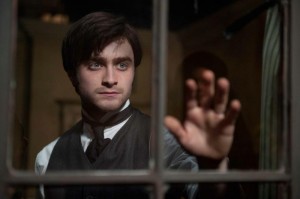THE WOMAN IN BLACK: 4 STARS
 Once again Daniel Radcliffe finds himself butting heads with the supernatural. No the Death Eaters and Lord Voldemort haven’t come back to haunt him, but a certain forlorn female ghost has. It’s not quite “Harry Potter Meets the Woman in Black,” but it’s almost as entertaining.
Once again Daniel Radcliffe finds himself butting heads with the supernatural. No the Death Eaters and Lord Voldemort haven’t come back to haunt him, but a certain forlorn female ghost has. It’s not quite “Harry Potter Meets the Woman in Black,” but it’s almost as entertaining.
Radcliffe is lawyer Arthur Kipps. Leaving his son behind in London, the widower travels to a remote English village to settle the affairs of Alice Drablow. Ms. Drablow may have shuffled off this mortal coil but the locals are convinced she still haunts her old house. Worse, because she still mourns her son Nathaniel, a toddler who drowned on her estate, whenever she is seen, a village child dies. His presence on her at her home, the dilapidated Eel Marsh House, stirs up her spirit, and soon the local children start dropping like flies. The question is, will he be able to get to the bottom of her sad tale before his son arrives from London and becomes a victim of the curse?
Based on Susan Hill’s novel of the same name, and interpreted by the storied Hammer Films, “The Woman in Black” is letter-perfect gothic horror. A sad gloom hangs over the entire picture, from the perma-dour look on Radcliffe’s face—his own son draws a picture of him with a downturned mouth explaining, ”That’s the way you look daddy.”—to the melancholy mist that envelopes the town to the dark shadows that color every scene.
And, as haunted houses go, this is a doozy. It’s remote, old and rambling. Doorknobs turn by themselves, faces appear in windows and there are stuffed monkeys and creepy Victorian children’s wind-up toys everywhere. With toys like this to play with it’s a wonder Victorian kids weren’t scared half-out-of-their-minds all the time.
Add to that the titular ghostly presence and you have a movie with lots of scares, but not the kind we’ve become used to. “The Woman in Black” revs up anticipation, playing on its ample atmosphere to create an aura of tension. When the frights do come, they’re effective because we’re primed for them. It’s an anti-torture-porn movie, an old-school horror film—there’s no blood and guts—but the shocks are effective and lasting.
Radcliffe is in virtually every scene and despite a lack of dialogue—most of the key scenes in the house are completely silent save for some spooky music—he anchors the film. It’s difficult not to see Harry Potter in his face but here he takes a good stride to step away from the typecasting of his most successful role.
